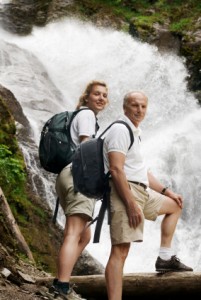Tips for Safe and Enjoyable Hiking
If you’re ill-equipped for it, what you plan on being a fun few hours in the great outdoors in  the summer sun can quickly turn into an experience you may never want to repeat. Hiking needs a little preparation if you’re going to get the most out of it. And while wearing appropriate clothing and packing the right foods are two ways in which you can make your hike truly memorable – for all the right reasons – there are one or two other aspects you also need to consider.
the summer sun can quickly turn into an experience you may never want to repeat. Hiking needs a little preparation if you’re going to get the most out of it. And while wearing appropriate clothing and packing the right foods are two ways in which you can make your hike truly memorable – for all the right reasons – there are one or two other aspects you also need to consider.
Plan Ahead
When planning your hike take your physical abilities into account and be realistic. If your fitness levels are on the low side, don’t commit to a strenuous 12-mile hike. Start off slowly and increase the distance you cover – if that’s your goal. Remember that, once started, you may not be able to abandon your hike but will have to see it through to the end, so make sure that you are able to do so.
For safety reasons, if you’re hiking alone, tell someone of your planned route and what time you expect to return.
Travel Light
Travel as light as you can. The heaviest items in your backpack should be your water bottle and food. Take essentials such as compass, map, flashlight (and batteries), whistle, sunglasses, as well as sunscreen and a hat if hiking in the summer. Sunglasses can be useful when hiking near water and in snow, as well as in the sunshine.
Wear a pair of hiking boots that have been worn in. If your hike involves crossing any stretches of water (e.g. streams), you may want to take a spare pair of socks in case your feet get wet. If rain is forecast, take a waterproof lightweight jacket.
Respect the Wildlife
If you risk being bitten by mosquitoes or other insects while hiking, wear a repellent or keep your skin covered with a loose, long-sleeved shirt, and loose, long pants.
Similarly, if there’s the possibility of encountering any larger wildlife on your hike, e.g. bears, take the necessary recommended precautions to ensure your safety.
Keep a Steady Pace
If you can keep up a conversation while you’re walking, you’re walking at the right pace. If you suffer from any physical or medical condition (heart problems, asthma, diabetes), limit your exertion and exposure to any heat. Always stay within your physical limitations and abilities.
Take Regular Breaks
Take a five minute break every 30 to 60 minutes. Sit down and elevate your legs above the level of your heart. This will help drain away the metabolic waste products built up in your legs during your hike. While you don’t need to do this every time you take a break, try to do it at least once an hour. Have something to eat and take in the view. Re-charging your batteries this way will help you complete the hike in relative comfort. Don’t look on these breaks as slowing you down; in the long run they’ll help you complete your hike faster.
Eat and Drink Often
Keep hydrated and eat often during your hike. Feeling thirsty means you’re already dehydrated – drink before you get thirsty.
It’s not just water you need when hiking though. You use a lot of energy when hiking, especially in the heat, so eating adequate amounts of food will help you to replace the salts lost through sweating. As with drinking water, eat before you get hungry – little and often is the best way. Pack foods such as dried or fresh fruit (depending on how much weight you want to carry in your backpack), nuts, crackers, seeds, and energy bars. You need foods rich in carbohydrate and protein to help keep your energy levels up when hiking. And remember to eat before, during, and after your hike.
